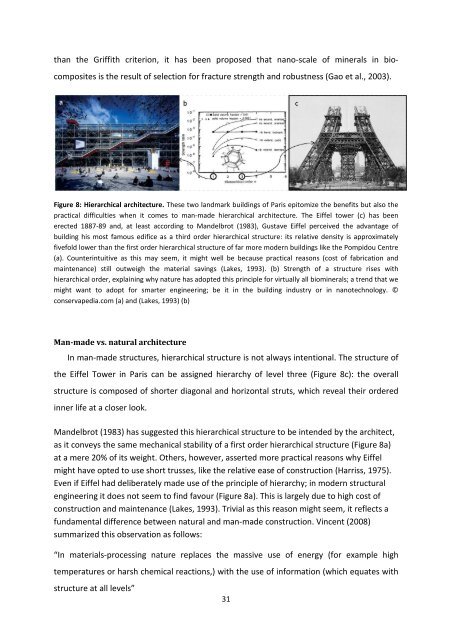MASTER THESIS Biomimetic potential of sponge ... - IAP/TU Wien
MASTER THESIS Biomimetic potential of sponge ... - IAP/TU Wien
MASTER THESIS Biomimetic potential of sponge ... - IAP/TU Wien
You also want an ePaper? Increase the reach of your titles
YUMPU automatically turns print PDFs into web optimized ePapers that Google loves.
than the Griffith criterion, it has been proposed that nano-scale <strong>of</strong> minerals in biocomposites<br />
is the result <strong>of</strong> selection for fracture strength and robustness (Gao et al., 2003).<br />
Figure 8: Hierarchical architecture. These two landmark buildings <strong>of</strong> Paris epitomize the benefits but also the<br />
practical difficulties when it comes to man-made hierarchical architecture. The Eiffel tower (c) has been<br />
erected 1887-89 and, at least according to Mandelbrot (1983), Gustave Eiffel perceived the advantage <strong>of</strong><br />
building his most famous edifice as a third order hierarchical structure: its relative density is approximately<br />
fivefold lower than the first order hierarchical structure <strong>of</strong> far more modern buildings like the Pompidou Centre<br />
(a). Counterintuitive as this may seem, it might well be because practical reasons (cost <strong>of</strong> fabrication and<br />
maintenance) still outweigh the material savings (Lakes, 1993). (b) Strength <strong>of</strong> a structure rises with<br />
hierarchical order, explaining why nature has adopted this principle for virtually all biominerals; a trend that we<br />
might want to adopt for smarter engineering; be it in the building industry or in nanotechnology. ©<br />
conservapedia.com (a) and (Lakes, 1993) (b)<br />
Man-made vs. natural architecture<br />
In man-made structures, hierarchical structure is not always intentional. The structure <strong>of</strong><br />
the Eiffel Tower in Paris can be assigned hierarchy <strong>of</strong> level three (Figure 8c): the overall<br />
structure is composed <strong>of</strong> shorter diagonal and horizontal struts, which reveal their ordered<br />
inner life at a closer look.<br />
Mandelbrot (1983) has suggested this hierarchical structure to be intended by the architect,<br />
as it conveys the same mechanical stability <strong>of</strong> a first order hierarchical structure (Figure 8a)<br />
at a mere 20% <strong>of</strong> its weight. Others, however, asserted more practical reasons why Eiffel<br />
might have opted to use short trusses, like the relative ease <strong>of</strong> construction (Harriss, 1975).<br />
Even if Eiffel had deliberately made use <strong>of</strong> the principle <strong>of</strong> hierarchy; in modern structural<br />
engineering it does not seem to find favour (Figure 8a). This is largely due to high cost <strong>of</strong><br />
construction and maintenance (Lakes, 1993). Trivial as this reason might seem, it reflects a<br />
fundamental difference between natural and man-made construction. Vincent (2008)<br />
summarized this observation as follows:<br />
“In materials-processing nature replaces the massive use <strong>of</strong> energy (for example high<br />
temperatures or harsh chemical reactions,) with the use <strong>of</strong> information (which equates with<br />
structure at all levels”<br />
31

















